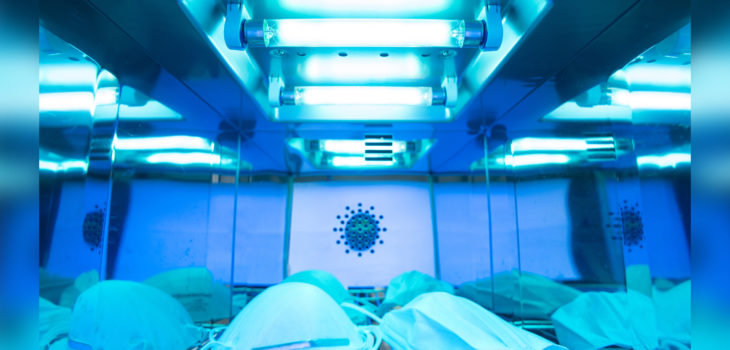 Blog
Blog
UV and COVID-19
T
he coronavirus vaccine gives us much needed hope that the end of this global pandemic is approaching, as many people want to leave their homes, return to work and get life back to normal. Social distancing, masks, sanitization and hand washing have become a part of, what is being termed, “the new normal”. While these measures have helped limit the spread of the virus to a certain extent, not all forms of transmission have been prevented. Particularly indoors and on surfaces have been a point of major concern for health authorities and countries. The scientific community studying the virus suggest that the novel SARS-CoV-2 stays alive in the air for a number of hours and on some surfaces – for days, going to a normal state of life seems to be a far-fetched hope for citizens.[1]
Universities and companies all over the world have been trying to find ways to disinfect surfaces and air to provide a safe environment for all. Ultraviolet light has been known for its disinfection capabilities since the late 1800s. Scientists discovered that shorter wavelengths, now called UV-C, of UV emitted by the sun, could kill bacteria. UV-C is the shortest and most effective form of ultraviolet, also called germicidal UV, which has been studied for its sterilization properties. Unlike the longer wavelengths of UV from the sun, UV-C rays are mostly filtered out by the ozone layer protecting the earth’s surface. This has enabled the use of this form of light for effective disinfection as the microbes have not had a chance to adapt to them. Hospital and water treatment plans have relied on UV-C to kill mold, viruses and other microorganisms.
Promising research has been conducted into the study of the effectiveness of UV-C Light on SARS-CoV-2. One of the first studies was done by Christiane et al. in December 2020 to prove the use of UV irradiation on the virus. The paper highlighted that the virus is highly susceptible to irradiation with ultraviolet light [1]. The team of researchers isolated the virus from the nasal swab of a patient suffering from COVID-19. UV exposure was conducted with UVC (254nm) and UVA (365nm) sources from Herolab, Germany. They achieved complete inactivation of the SARS-CoV-2 in 9 minutes at a total emitted dose of 1048mJ/cm2 and confirmed that UV-C irradiation is an effective method for inactivation of the virus.
Another study, published in November 2020, by researchers of Tel Aviv University (TAU) provided similar findings. These researchers used UV-LEDs and have concluded the optimal wavelength for killing the coronavirus. They reported that UV-LEDs operating at a peak wavelength of 285 nm was most efficient considering cost and availability. [2]
“It doesn’t kill the virus — it renders it unable to reproduce,” says Jim Bolton, Environmental engineer, University of Alberta in conversation with Leslie Nemo
As a result of some studies, UV-C light emitting machines are being utilized in empty subway cars, buses and trams for sterilization. The technology has slowly made its way into consumer culture as well in the form of UV-C wands, lamps and devices for homes and office spaces.
UV-C has found its way into multiple applications during the course of the global pandemic. It has been proven for its effectiveness in the removal of bacteria from water and disinfects surfaces. Some new devices have been introduced into the market. LARQ self-cleaning bottle is one of them. Labelled as “the world’s first self-cleaning bottle and purification system”, it uses UV-C LED light to eliminate bio-contaminants from the bottle [5]. Some other products that were introduced during this time are – the LG wireless earbuds [4], SEIT-UV Autonomous disinfection Robot [3] and Perscientx Violet [6]
With UV light making a mark as an efficient way to kill the virus, more and more interest grew in the use of it to disinfect spaces and surfaces. The city of New York tested the use of ultraviolet lamps to kill the virus on buses and subways. [7]

There is an increasing focus on the addition of UV technology for air treatment in the transport industry. The Sonoma Marin Area Rail Transit (SMART) installed UV Light sterilization on their trains on a trial run in 2020 and have been using this technology since. [8]
As a result of increased interest and results, many governments across the globe have taken measures to fully understand the use of UV light to provide safety to their citizens. A new initiative announced in Australia, according to SBS News, mentioned that the federal government has announced 10 million USD for clinical trials of some coronavirus-related technologies. [9]
There has been a huge rise in the number of UV devices in the market due to COVID-19. But, here is the bad news- yes, there are some great results that have been seen using a UV light for disinfection, but not all devices in the market do the job. Some manufacturers use words such as “sterilizing”, “disinfecting” and “germicidal” to reference a device’s ability to kill germs but do not mention which germs. UV-C rays are not safe for human exposure. Some of the devices in the market, claiming to be UV-C, emit completely different wavelengths of light. UV-C light is in the range of 100-290nm whereas the devices that are in the market emit light in the range of 400-500nm(giving a purple hue when seen by the user).

Be aware of such devices and it is highly recommended not to buy them. The international organization for standardization(ISO) has set out documents for safety limits while handling UV-C Devices in ISO 15858:2016. The European Commission has a safety gate alert system that will help to stay away from these dangerous devices. It can be found on https://ec.europa.eu/consumers/consumers_safety/safety_products/rapex/alerts . If you type in – UVC in the free text category, a large list of products that have been banned from the market can be seen. The lighting industry association of UK, in September 2020, released an article warning all users about potentially dangerous products and advising not to buy any UV-C products without seeks assurances that they are safe for use.[10]
Bottom Line
The most effective type of UV light to kill the coronavirus is UV-C. It can effectively disinfect surfaces and spaces. Due care must be taken while choosing the device to do the task depending on the target. While it can disinfect and sterilize the region targeted, the user must be at a safe distance and limit exposure to UV irradiation.

REFERENCES
- Heilingloh, C.S., Aufderhorst, U.W., Schipper, L., Dittmer, U., Witzke, O., Yang, D., Zheng, X.,Sutter, K., Trilling, M., Alt, M., Steinmann, E., Krawczyk, A., 2020. Susceptibility ofSARS-CoV-2 to UV irradiation. Am. J. Infect. Control 48, 1273–1275. https://doi.org/10.1016/j.ajic.2020.07.031.
- Gerchman, Y., Mamane, H., Friedman, N., Mandelboim, M., 2020. UV-LED disinfection ofcoronavirus: wavelength effect. J. Photochem. Photobiol. B Biol. 212, 112044. https://doi.org/10.1016/j.jphotobiol.2020.112044
- https://www.youtube.com/watch?v=JTFH9X2YIoY
- https://www.lg.com/us/headphones/lg-hbs-fn6-black-tone-free
- https://techgadgetscanada.com/larq-self-cleaning-water-bottle-review/
- https://www.youtube.com/watch?v=HsI8GLnuDbM&feature=youtu.be
- https://www.cbsnews.com/news/new-york-city-subway-ultraviolet-light-coronavirus-mta/
- https://www.sonomawest.com/the_windsor_times/news/smart-to-install-uv-light-sterilization-on-trains/article_48e2e5a8-4a41-11eb-8d2b-0f539b305694.html
- https://www.sbs.com.au/news/uv-light-3d-printed-face-masks-federal-government-announces-10m-for-coronavirus-related-medical-trials
- https://www.luxreview.com/2020/09/11/beware-of-dangerous-uv-c-lighting-products-lia-warns/


